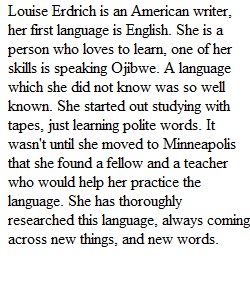


Q Threshold Concepts: [ENGAGEMENT] Meaningful writing is achieved though sustained engagement in literate practices. In this case, reading accurately to summarize key ideas. Read: Two Languages in Mind, But Just One in Heart (Links to an external site.) and write a paragraph summary. Instructions: Use the following information as a guideline as you write your summary. Word Count: 100-150 words. I. Summary Purpose To write persuasively, you must be aware of what others say about your issue. As a result, being able to fairly summarize what others say is central to your development as an effective writer. For the most part, writers summarize for two reasons: To represent an author’s overall argument to which they want to respond; or to summarize an author’s position in terms of their particular argument’s focus. For this notebook, in preparation for the Rhetorical Analysis, you will summarize each author’s overall argument. To begin the summary process, 1. Skim the source to form an idea of its content and structure. 2. Reread the source and break it into sections Introduction: Look for the thesis (look in the conclusion for it, too) Body: Look for a key point in each paragraph or a key point in a group of paragraphs that form a section Conclusion: Look for a statement of significance about the thesis/issue--one that emphasizes the impact of the issue 3. Pull the thesis and key points from each section - introduction, body, conclusion -and compose them into a coherent summary, leaving out (most) evidence. II. Structure A summary should follow the order of the original source unless there is a compelling reason not to do so. For example, summaries should always state the source’s thesis, along with the author and title of the source, in its opening sentences regardless of where it is stated in the original source. III. Criteria To write an effective summary, please use the following criteria • Introduce the author, title, publication, and thesis of the source in the first sentence or two • Represent the original article accurately and fairly • Be direct and concise, using words economically • Remain objective and neutral, not revealing your own ideas on the subject, but only the original author’s points • Use your own words (paraphrase) to express the original author’s ideas and quote sparingly; provide page numbers in parentheses if you do quote • Keep your reader informed that you are summarizing another’s ideas by using attributive tags, such as “The author argues that…” to frame each sentence of the summary. • Create a summary that is a unified coherent piece of writing in its own right. PreviousNext
View Related Questions